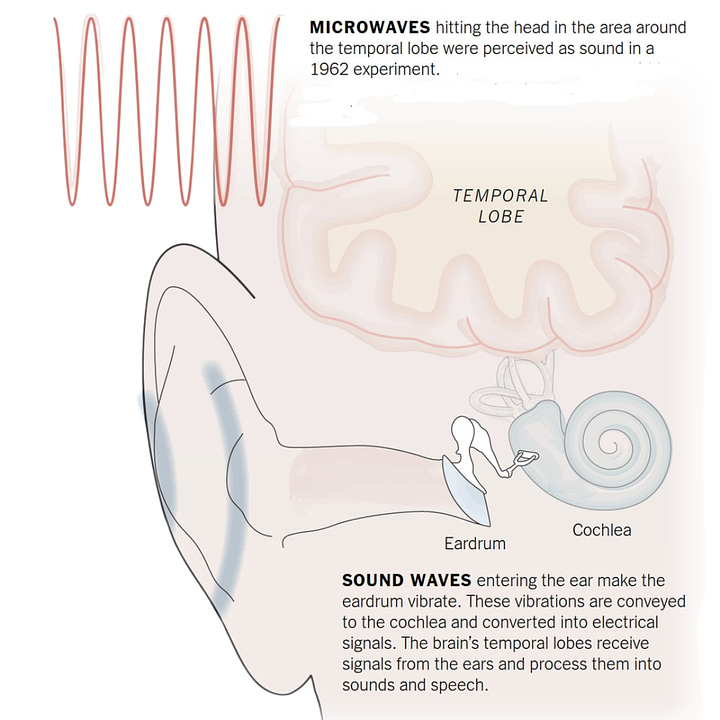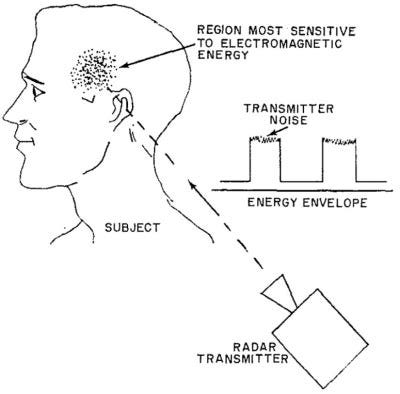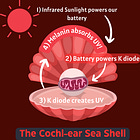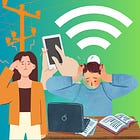Here’s what we’ll learn in this article:
1. How was microwave hearing discovered?
2. The tinfoil hat
3. How electricity generates sound
6. Can deaf people hear?
7. What does electricity sound like?
8. How tinnitus is becoming an epidemic
9. Our Blood Brain Barrier
All articles are free. However, your support as a paid subscriber enables us to continue producing high-quality, independent research on important health topics like EMF.
As an ad-free platform, we rely on the support of our readers to keep this content accessible and free from external influence.
Ever wonder where the phrase tin foil hat comes from?
This phrase is often ridiculed because we don’t understand the concept of sound.
Many of us don’t know how we hear.
How can the deaf hear the same sounds and frequencies as those who are not deaf?
Microwave hearing
In 1960, the sounds of silence struck a chord.
Biologist Allan H. Frey, who was employed at General Electric’s (GE) Advanced Electronics Center at Cornell University, bumped into a fellow technician at GE who told Frey that he could hear radar. Frey remembers walking to the man’s work site near Syracuse: “When I walked around there and climbed up to stand at the edge of the pulsating beam, I could hear it, too…going zip-zip-zip.” The auditory phenomenon of microwave sound was also described as a “buzz, click, hiss or bump.”
Even before 1960, Frey, being a curious man, was fascinated with how electricity in the air affects our nervous system. This chance encounter in Syracuse led Frey to quit his job at GE and pursue full-time research into the effects of microwave radiation. In 1961, he published his first paper on “microwave hearing.”1 The microwave auditory effect (MAE) is commonly known as the Frey effect. Frey would spend the next twenty years researching the effects of microwaves on the auditory and nervous system, the eyes, brain, and the heart.2
The tinfoil hat
In his studies, which were funded by the Office of Naval Research and the US Army, Frey discovered that when a metal shield in the form of an aluminum mesh/ screen was placed between the subject and the radar, no microwave sounds were heard.3 The aluminum was placed on our temporal region, where we are most sensitive to electromagnetic fields (EMFs).
Many people who complain of “microwave hearing” (including myself) can sense that these sounds emanate not from our ear, but right in front, by the location of our brain's temporal lobe (where our temples are). This is due to the fact that the cells in our ears’ cochlea are known to be piezoelectric crystals, i.e. they will convert electric currents to sound.4


How is sound generated in our ears?
The standard theory of hearing used to be that our ear drums vibrate, and this causes the hair cells of our ears to bend, triggering nerve impulses. However this theory was always mechanical in nature, and disregarded the role of electricity. Ever since Volta invented the battery in the 1800s, the role of electricity as a vital life force was downplayed by barons of the Industrial Age.
Electricity was promoted as separate from the life force, because if such an élan vital was inherent in all of us, the health effects of electrification of the Earth’s power grid in 1889 could not have been dismissed as easily. Doctors of the19th century would have had to admit that anxiety nervosa, a term invented by Freud to convey a disease of “bad thoughts” and hysteria, was actually a physical phenomenon of the nervous system being affected by manmade electrical wiring, as explained in the following article:
As far back as 1933, scientists of the day were challenging this mechanical version of hearing. Augustus Pohlman, an anatomy professor and dean of the school of medicine at the University of South Dakota, was such a man. He believed that the hair cells of the ear were pressure sensors, which would explain how the ear could be so extremely sensitive. This also explained why the cochlea is embedded in the densest bone in the human body: the cochlea is a soundproof chamber.
The cochlea converts so much environmental information, that a quantum-electrical, rather than mechanical, process would fit the bill:
“No bigger than a hazelnut, the cochlea is able to take the roar of a lion, the song of a nightingale, and the squeak of a mouse, and reproduce them all with perfect fidelity in the form of electrical signals sent to the brain.”
-
, The Invisible RainbowEnglish physician and biochemist Lionel Naftalin studied the inner workings of the ear for fifty years, up until his death at age 96 in 2011. Naftalin believed that electrical forces were central. He focused attention on the tectorial membrane, a jelly-like substance that is both a semiconductor and piezoelectric liquid crystal:
Piezoelectric substances are able to convert electrical voltage into mechanical pressure, and vice versa. Quartz crystals are such an example, and are used in radio receivers to convert electrical vibrations into sound.
Semiconductors are used in electronics and computers, because they are able to relay a tremendous amount of data using electrical transmission. Turns out we operate the same way! For information on how the melanin in our ears converts light into information that we hear:
Can deaf people hear?
Many mainstream science websites state that human hearing is in the audible frequency range, between 20-20,000Hz (Hz = cycles per second). This is incorrect.
Since the 1940s, there has been much scientific literature proving that humans, even the deaf, can hear in the ultrasonic frequency range of 20,000-225,000 Hz, a range previously relegated to the likes of bats and dolphins.5
The ability to hear these tones depends on the health of the acoustic nerve. The deaf have what is called conduction deafness, and not nerve deafness. Even since 1925, amateur radio enthusiasts found that deaf people, whose eardrums could no longer function properly, but whose (acoustic) nerve centers are intact, can hear radio.6 The deaf were able to hear when an electrode was applied to the surface of the skin, which vibrated and created sound by reaching the inner ear through bone conduction.7
In 1936, this phenomenon was named “electrophonic hearing” by Harvard psychologist Stanley Stevens. In 1958, a young inventor by the name of Patrick Flanagan would apply the work of Stevens by inventing the Neurophone, which is still used today. This device works by skin vibration as well, but uses a carrier frequency in the ultrasonic range.
What does electricity sound like?
How come (thank God) we don’t hear the sound from our power outlets, which are only 60 Hz?
There is evidence emerging that our ears are around 5,000 to 10,000 time more sensitive to ultrasonic frequencies than at power line frequencies. This is due to the fact that our outer, middle, and inner ear resonate with those higher ranges right before they are transformed into electrical impulses.8
Each person’s sensitivity to these ranges does vary, however. Sensitivity depends on many factors such as overall nerve health and individual anatomy. As long as our nerves are intact, we are able to hear sounds in the higher frequency range. Some of us may perceive them as a hiss, buzz, or even the clicking of a woodpecker, which is the sound that a standard 2.45GHz Wi-Fi modem makes:
What Wi-Fi sounds like:
More EMF Sounds (Credit: Safe Living Technologies)
The electrosensitive population
Did you know that 0.65 percent of the world population can’t go to work due to their incapacitation by EMFs? This equates to roughly 2.3 million individuals in the US, and about 500,000 in the UK. These individuals suffer from what is known as electromagnetic hypersensitivity (EHS), and are modern society’s canaries of the technological coalmine.
Sensitivity is both a blessing and a curse, as this means nerves are doing their job, alerting of potential danger, however many EHS individuals are affected by subtle changes in sound and vibration, and tend to suffer from hearing afflictions such as tinnitus.
“The prevalence of people restricted in their access to work in a man-made electro-
magnetic environment is estimated at 0.65 per cent of the general population, at about 18% of the general population with moderate EHS.”
-Dr. Michael Bevington, MEd. Chair of Trustees of ES-UK
Ringing in our Ears
Rates of tinnitus have been rising for at least the last thirty years, and climbed by one-third from 1982-1996 alone.9 By 2004, over 50 million adults were found to suffer from tinnitus. The surprising fact, found by a US nationwide survey conducted in 2010 by the Better Hearing Institute, was that 44 percent of Americans who complained of ringing in their ears said they had normal hearing. Researchers falsely assumed that the subjects of the study had hearing loss but did not know it.
Similar hearing studies had already been conducted at the University of Madison Wisconsin in 1995 with a follow-up in 2008. These researchers had expected to see a decline in tinnitis, as hearing disorders among older adults declined. However they found just the opposite: a steady increase in tinnitus in all age groups occurred during the 1990s and 2000s, increasing at a rate of about 50 percent.10
Studies on seven-year-old children by professor of audiology Kajsa-Mia Holgers at the University of Jonkoping in Sweden, conducted in 1997 and 2005, revealed a staggering 42 percent of children reporting ringing in their ears. Holgers also found that more than half of high school students aged 13 to 16 reported tinnitus in some form during the 2003-2004 school year. In 2004, school children aged 9 to 16 reported tinnitus, and 14 percent heard it everyday.
Why would children, who normally have very healthy hearing, be experiencing tinnitus?
If a child or adult has otherwise healthy hearing, then we must look at what may be causing this disturbance in our environment.
We know that we can hear electromagnetic energy in the ultrasonic range from 20 kHz to about 225 kHz.
What transmits at 20 kHz- 225 kHz?
The same radiowaves and radar that Frey could hear, and proved to be audible in his studies, which have been increasingly surrounding us since the 1940s.
Leakage of our Blood Brain Barrier
Frey also discovered that certain pulsed microwave beams, which increased the permeability of the blood-brain barrier (BBB), could be turned into a weapon to enhance the effects of drugs, bacteria, or poisons.1112 This barrier is a protective shield that normally keeps bacteria, viruses, and toxic chemicals out of our brain. The BBB also selectively allows nutrients and neurotransmitters (dopamine, serotonin, melatonin) in so our brains can function properly, as well as maintain constant pressure inside our heads so we don't have a stroke.
The increased permeability of the BBB triggered by electromagnetic fields (EMFs) can contribute to a wide variety of complications, including cancer and neurodegenerative processes like Parkinson's and Alzheimer’s.1314
Here’s another fascinating aspect of how ELFs (extremely low frequencies) can impact our physiology, from Ray “The Source”:
What can we do about the mess we find ourselves in?
There are many strategies we can apply on a daily basis, which I’ll be sharing in upcoming articles.
Raising awareness, and knowing our enemy, is the first step toward a resolution.
If you’ve found this article valuable, please consider sharing and supporting my work with a paid subscription, as this allows me to continue to dive deeper and allocate more time toward research and activism.
Thank you all so very much.
If you have any comments or questions, I’m all ears.
Please help support our research and fund independent journalism:
Consider becoming a paid subscriber:
Listen to our Podcast on ancestral wellness.
If you enjoyed this article and found it valuable, would you consider sharing it?
Firstenberg, A. The Invisible Rainbow. 2020, pp. 175-177
Chou & Guy 1979: 193–197
Firstenberg, A. The Invisible Rainbow. 2020, p. 300
Imaizumi, H. Hosoi, “Ultrasound activates the auditory cortex of profoundly deaf subjects.” Neuroreport. (March 2001) doi:10.1097/00001756-200103050-00030
Firstenberg, A. The Invisible Rainbow. 2020, p. 282
Meyer, 1931.
Stevens, 1937.
National Center for Health Statistics, 1982-1996.
Nohndahl et al. 2012.
Becker, R. The Body Electric.1985, p. 318
Parathath SR, Tsirka SE. “Nitric Oxide Medites Neurodegeneration and Breakdown of the Blood-Brain Barrier in tPA-Dependent Excitotixic Injury in Mice.” Journal of Cell Science. Vol. 119. (Januuary 15, 2006): 339-349
Mercola, J. EMF*D: 5G, Wi-Fi & Cell Phones: Hidden Harms and How to Protect Yourself. 2020, p.125










I've had tinnitus for over 20 years. Then I was advised to try drinking silicon-enriched water, and to my amazement, during one week of drinking 1-1 1/2 liter VOLVIC (with 32mg silica per litre) per day, my tinnitus dropped by at least 50% half of the time! In fact, part of that time the tinnitus was gone. So as you will understand, now I'm regularly on Volvic.
I learnt that silica helps dissolve and flush out aluminium particles, which otherwise are too large and stay put in the brain. I would be very pleased to know if you/anyone can explain this.
As usual, thank you. I think it is important for us all to understand that the issues we are now facing are much larger than "just" 5G. Before 5G, I had syndrome style health issues that I did not link to electricity generally, although I did explore devices to protect against cell phone radiation back in the early days of cell phones. I was worried then but could prove nothing so pretty much got distracted from the subject until 5G arrived. It was 5G coming to my local area that pushed me over the edge into a virtually perpetual state of pain that I can no longer successfully manage, accompanied by occasional severe digestive collapse, whence my renewed and now urgent interest.
For your readers potential interest, tinnitus is a common component of what is called long covid (which I think is really 5G sensitivity) and there is a vagus nerve exercise which removes it - I do not know how but I have attached a video below. It has worked for me, and has removed a few different known long covid symptoms controlled by the vagus nerve.
https://www.youtube.com/watch?v=rbowIy6kONY
You might find it instructive to get onto a few of the long covid facebook groups. They ban discussion of 5G and vaccination, so much of what is reported there is vaccine injury, not covid injury, but even then you will be able to identify a huge proportion of the medical complaints reported there are autonomic nervous system issues. Having watched this over many months now, I can only respond in terms of the body's electrical system, but am not permitted to take it back one more step to what is actually disrupting the body's electrical system.